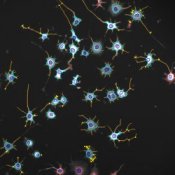If you look Jang Dong-kun, first you may experience an increase in your heart rate, and your hands may push toward him, naturally. In this situation, acetylcholine makes your eyes bigger and your heart beat faster. Sometimes you may have pain from your high heels and grow impatient with your boyfriend. Perhaps you felt mentally tortured by your midterm exams. Actually, these phenomena in your body would not occur without your nervous system. In the cases above, your nervous system collects, distributes and integrates information. This is the point of neurobiology.
In Our Body, Electricity Flows
Do you know that our bodies have electricity and the electrical current is essential for our various reactions to the external environment? There is a well-known story. If you fall in love with someone at the first meeting, electricity flows between you and that person. That is a well-known story and makes some sense. The stronger stimulus you get, the greater voltage occurs in your body. And the transmission of the current might describe all of your behavior. Let’s know that electricity affects how our body behaves to the surroundings, through simple reflex. Suppose that you thoughtlessly steps on a thumbtack. A trauma of your skin is translated into electrical signals in your body and that travel up our body’s specific path, called sensory nerve fibers. The path which transports sensation gathered in one specific area, so called spinal cord. The spinal cord also has motor nerve fibers, which are able to move your skeletal muscles, as well as sensory nerve fibers. Another path for electricity called motor nerve fibers is connected to skeletal muscle, and as a result, you can move your foot, shouting suddenly “Oops!” Of course, most of your activities including thinking, calculating, breathing etc. are regulated by the brain; following the path from the spinal cord to the brain and back to the spinal cord.
In Synapse, What’s Going on?
The nervous system consists of two systems, central nervous system and peripheral nervous system. Central nervous system is composed of a brain and a spinal cord. Peripheral nervous system is composed of other neurons through out our body. Also, the nervous system is composed of two kinds of cells, largely: neurons and neuroglia (commonly called glia) cells. If a neuron is a popular singer, glia cells are his numerous fans. In the human brain, glias outnumber neurons by tenfold. Glial cells are helpers who are functioning by insulating, supporting, and nourishing neighboring neurons. It is the neurons that sense changes in the environment, communicate these changes to other neurons, and command the body’s response to these sensations, through neurotransmitter. Neurons have a cell body, called soma, and neurites radiating away from soma. And neurites consists of two different types: axons and dendrites. If you can draw long single axon (in most cases) and relatively more branched dendrites in your mind, your first base work for understanding nervous system is completed. After, signal is sent to axon terminal (the end of axon), through long path of axon, it releases neurotransmitter. And then dendrites of next neuron receive them. The structure where one cell sends signals and neighboring next cell receive signals is called ‘synapse.’ In addition, the space between pre-synaptic cell (usually, axon terminal) and post-synaptic cell (in most of cases, dendrites) is called ‘synaptic cleft.’ You can easily think about neurotransmitter, the material distributed by axon terminal, can be transported through synapse.
Neurotransmitter and Receptors
There are many kinds of neurotransmitter in your body. And the materials function by attaching to specific receptors each other. Glutamate is the most general form of neurotransmitter in the brain. If dendrites receive sufficient glutamate in the brain, glutamate-gated ion channel (channel which are opening or closing by the attachment of glutamate in the post-synaptic membrane) opens. As a result, glutamate comes to cause transient postsynaptic membrane depolarization, and Excitatory Post Synaptic Potential (EPSP) occurs. Have you heard of Monosodium Glutamate (MSG), main component of artificial seasoning? This material was used for student’s schoolwork improvement by ardent parents. However, a few years ago, its problems have been revealed more and more. Researchers discovered that frequent and many doses of it make taste sense decrease, and mental disorder may occur.
What’s the problem in Menstrual Pains?
If you are a woman, you may have thought about the cause of menstrual pains. Of course, the original cause is the breaking of endometrium. But, the effect neurotransmitter cannot be ignored. Contrary to excitatory glutamate-gated channel, there are Gamma Amino Butyric Acid (GABA)–gated channel and Glycine-gated channel functioning inhibitory channel. Gating(opening and closing) of these two channels are regulated by GABA and Glycine each other. As high concentration of neurosteroid in your menstruation come to block GABA channel and this channel close, inhibitory effect of relieving pain is suppressed. If the amount of GABA and glycine increases and opening time of the two channels is continued than usual, depression might occur as inhibitory body actions were promoted.
Science is a reality. Neuroscience in particular, describes various transduction and reaction in our body. This is the nervous system. It is essential for your survival that you get external stimulus and then you react to it. The way you do this is through neurotransmitters, numerous neuron and glia cells.


